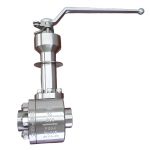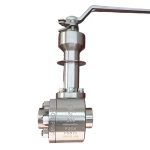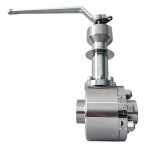TIANYU 800LB 3/4” SS304 Socket Weld Floating Ball Valve: Soft-Sealed Ultra-Low Temperature Solution for Industrial Cryogenic Systems
I. Product Overview
II. Key Attribute Specifications
A. Dimensional & Pressure Parameters
- Port Size: 3/4” (DN20), optimized for small-bore cryogenic pipelines where precise flow control and minimal pressure drop are essential.
- Pressure Rating: 800LB (13.8MPa working pressure), with hydrostatic test pressure at 1.5×rated pressure (20.7MPa) for shell integrity and 1.1×rated pressure (15.2MPa) for seat sealing, ensuring reliability in high-pressure cryogenic systems.
- Temperature Range: -196℃~150℃, enabled by SS304 stainless steel’s cryogenic toughness (maintains ductility at -196℃) and soft sealing materials compatible with ultra-low temperatures (e.g., PTFE, RPTFE, or cryogenic-grade elastomers).
B. Material Composition
- Valve Body & Ball: SS304 stainless steel (ASTM A182 F304), containing 18-20% chromium and 8-10.5% nickel. This alloy retains excellent mechanical properties (tensile strength ≥515MPa, yield strength ≥205MPa) and corrosion resistance in cryogenic environments, while avoiding cold brittleness at -196℃.
- Sealing System: Soft sealing materials tailored for ultra-low temperatures:
- PTFE (Polytetrafluoroethylene): Standard option, resistant to cryogenic fluids, chemically inert, and effective from -196℃ to 260℃.
- RPTFE (Reinforced PTFE): Optional for enhanced mechanical strength, suitable for higher-pressure cryogenic applications.
- Cryogenic Elastomers (e.g., Perfluoroelastomer): For applications requiring elastomeric sealing with flexibility at -100℃ to -150℃.
- Stem & Handle: Stem: SS304 stainless steel, precision-machined for smooth operation; Handle: SS304 with internal thread connection, enabling manual 90° rotation for quick on-off control.
C. Connection & Operational Features
- Connection Type: Socket weld (SW), conforming to ASME B16.11. Socket weld joints provide leak-tight integrity in high-pressure, cryogenic systems by fusing the valve and pipeline via welding, eliminating gasket-related leakage risks.
- Operation Mode: Manual, with an internal thread handle. The handle’s ergonomic design reduces operating torque, making it feasible to operate the valve even in gloved conditions typical of cryogenic facilities.
- Leakage Class: ANSI/FCI Class VI (soft seal), ensuring “bubble-tight” sealing (≤0.1×DN mm³/min leakage), critical for preventing loss of expensive cryogenic media (e.g., LNG) or maintaining system vacuum in air separation units.
III. Feature Description
A. Floating Ball Design for Cryogenic Sealing
B. SS304 Stainless Steel: Cryogenic Toughness & Corrosion Resistance
- Cryogenic Toughness: Unlike carbon steel, which becomes brittle at low temperatures, SS304 retains ductility at -196℃. This prevents valve body or ball fracture under thermal shock (e.g., rapid filling with liquid nitrogen).
- Corrosion Resistance: In cryogenic systems handling liquefied gases (e.g., LNG, which contains trace moisture and acids), SS304 resists pitting, crevice corrosion, and stress corrosion cracking, ensuring long-term material integrity.
C. Socket Weld Connection: Leak-Tight Integrity in Cryogenic Systems
- Welded Seamlessness: By welding the valve socket to the pipeline, the joint becomes a monolithic structure, eliminating gasket interfaces that could leak or fail under thermal cycling (a common issue in cryogenic systems where temperature swings cause gasket compression loss).
- High-Pressure Capability: Socket weld’s mechanical strength exceeds that of threaded connections, making it suitable for 800LB pressure ratings while maintaining leak-tightness at -196℃.
D. Ultra-Low Temperature Compatibility of Soft Seals
- PTFE: Maintains chemical inertness and low friction at cryogenic temperatures, with a service temperature range of -196℃ to 260℃. It doesn’t harden or lose sealing ability in liquid nitrogen or liquid oxygen service.
- Cryogenic Elastomers: For applications requiring elastomeric sealing (e.g., better conformability to seat irregularities), perfluoroelastomers can operate down to -100℃, providing flexible sealing in less extreme cryogenic ranges.
IV. Manufacturing Processes
A. Material Inspection & Preparation
- SS304 Verification: Raw SS304 bars undergo spectral analysis to confirm chemical composition (Cr: 18-20%, Ni: 8-10.5%) and mechanical testing (tensile, impact at -196℃) to ensure cryogenic toughness meets ASTM A182 standards.
- Seal Material Testing: Soft seals (PTFE/RPTFE) are tested for dimensional stability and compression set at -196℃ to verify they retain sealing properties after prolonged cryogenic exposure.
B. Precision Machining of Components
- Valve Body & Ball: The body is CNC-machined from SS304 bar stock, with socket weld ends machined to ASME B16.11 dimensions (socket depth, wall thickness). The ball is turned to a spherical tolerance of ±0.02mm, then lapped to a surface roughness of Ra ≤0.8μm for uniform seal contact.
- Stem & Handle: The stem is ground to a diameter tolerance of h7 (±0.015mm) and polished to reduce friction with packing. The handle is machined with internal threads matching the stem, ensuring secure attachment and smooth torque transmission.
C. Assembly & Sealing Integration
- Seal Installation: PTFE seals are precision-cut and installed into the valve seat pockets, with spring-loading (optional) to compensate for thermal contraction. The ball is inserted, and the stem is connected, with packing (graphite-impregnated PTFE) installed to prevent cryogenic media leakage along the stem.
- Socket Weld Preparation: The valve’s socket ends are machined to ensure proper fit-up with pipeline ends, with beveled edges for full penetration welding.
D. Quality Testing & Cryogenic Validation
- Hydrostatic Test: The valve is pressurized to 20.7MPa (1.5×800LB) for 30 minutes (shell) and 15.2MPa (1.1×800LB) for 15 minutes (seat), with no leakage or deformation allowed.
- Cryogenic Cycle Test: The valve is cooled to -196℃ using liquid nitrogen, held for 4 hours, then subjected to 100 open-close cycles. Leakage is tested before and after cooling to ensure ANSI/FCI Class VI compliance.
- Torque Testing: Manual operation torque is measured at room and cryogenic temperatures to ensure it remains within acceptable limits (≤150 N·m for 3/4” 800LB valve).

V. Product Advantages
A. Reliable Cryogenic Sealing
B. Material Longevity in Extreme Cold
C. Leak-Tight Socket Weld Connection
D. Cost-Effective & Easy Operation
VI. Product Applications
A. LNG Industry
- LNG Sampling Systems: Controls flow of LNG samples (-162℃) for quality analysis. The soft seal prevents LNG vapor leakage, ensuring accurate sampling and workplace safety.
- LNG Vehicle Fueling Stations: Regulates LNG flow to dispensers. Socket weld connections withstand frequent thermal cycling (LNG filling/standby), while SS304 resists corrosion from ambient moisture.
B. Air Separation Plants
- LOX/LIN Pipelines: Manages flow of liquid oxygen (LOX, -183℃) or liquid nitrogen (LIN, -196℃) in air separation units. The valve’s cryogenic toughness prevents fracture during rapid LOX/LIN filling, and soft seals maintain vacuum integrity in distillation columns.
C. Cryogenic Chemical Processing
- Low-Temperature Reactors: Controls flow of cryogenic reactants (e.g., liquid ethylene at -104℃) in polymerization processes. SS304 resists corrosion from trace reactor chemicals, and socket weld ensures leak-tightness for hazardous materials.
D. Medical & Research Facilities
- Liquid Helium Systems: Manages flow of liquid helium (-269℃, near absolute zero) in MRI cooling systems or physics research labs. While SS304 is limited to -196℃, optional 316L or cryogenic alloys (available via customization) extend applicability to 4.2K (-268.95℃) service.
E. Industrial Refrigeration
- Cold Storage Compressor Lines: Regulates flow of refrigerant gases (e.g., R-23 at -82℃) in industrial cold storage systems. Soft seals prevent refrigerant leakage, ensuring efficient cooling and environmental compliance (no ozone-depleting emissions).
RELATED
-

High Temperature/Pressure 304 Stainless Steel Resistant Manual Power Forged Three Piece Flanged Floating Ball Valve
TIANYU 304 Stainless Steel Flanged Floating Ball Valve: Corrosion-Resistant Full-Port Flow Control Solution for Industrial, Sanitary, and Municipal Me…
BALL VALVE 11/03/2025 -

API ANSI 2in-16in DN50-DN400 PN10 PN16 CF8M Pneumatic Flanged Floating Ball Valve
TIANYU CF8M Pneumatic Flanged Floating Ball Valve: 2in-16in (DN50-DN400) PN10-PN16 API/ANSI Class Corrosion-Resistant Flow Control Solution for Indust…
BALL VALVE 11/01/2025 -

Large-Diameter DN1400 CLASS150 WCB SS Triple Eccentric Metal-Sealed Hard Seal Butterfly Valve
TIANYU DN1400 (56″) CLASS 150 WCB Hard Seal Butterfly Valve: Triple Eccentric Metal-Sealed Flanged Valve for Large-Diameter Industrial Media wit…
BUTTERFLY VALVE 10/30/2025 -

PN16 Stainless Steel Floating Ball Valve: Full Port 2PC Flange-Connected Valve with Fire-Safe & Anti-Static SS Ball Valve
TIANYU Stainless Steel Floating Ball Valve: Full Port 2PC Flange-Connected Valve with Fire-Safe & Anti-Static Design for Oil, Gas, and Industrial …
BALL VALVE 10/29/2025 -

High-Performance DN80 Class 150 WCB Soft-Sealed Lug-Type Double Eccentric Butterfly Valve
TIANYU 3” Class 150 WCB lug-type double eccentric butterfly valve is a technologically advanced flow control device engineered to address the challeng…
BUTTERFLY VALVE 10/25/2025 -

DN125 PN16 CF8M Stainless Steel Lug-Type Butterfly Valve with PTFE Lining Concentric Line Butterfly Valves
TIANYU DN125 PN16 CF8M stainless steel lug-type butterfly valve is a precision-engineered flow control device designed to address the challenges of ha…
BUTTERFLY VALVE 10/25/2025







